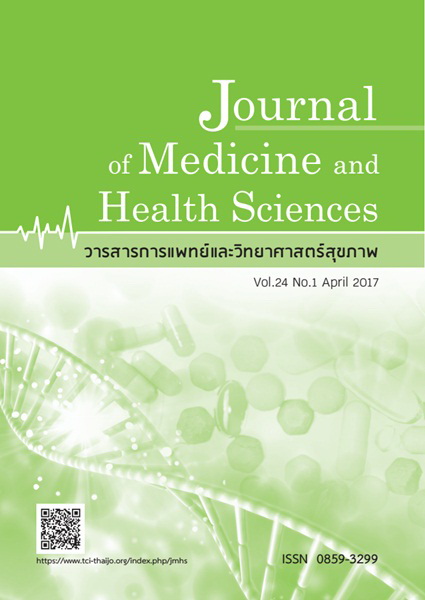ปริมาณการใช้ก๊าซดมสลบเมื่อเฝ้าติดตามความลึกของการหลับโดยใช้ bispectral index เปรียบเทียบกับการใช้สัญญาณชีพ/Volatile anesthetic consumption by bispectral index monitoring compared to hemodynamic monitoring
Keywords:
bispectral index (BIS), awareness, general anesthesia, autoflow, volatile anesthetic consumption ความลึกของการหลับ/bispectral index(BIS), generalanesthesia, volatile anesthetic consumption, depth of anesthesiaAbstract
บทคัดย่อ
Bispectral index (BIS)เป็นวิธีที่ช่วยวัดความลึกของการหลับโดยอาศัยการวิเคราะห์และแปลผลจากคลื่นไฟฟ้าสมอง โดยค่าBIS ระหว่าง 40-60สามารถป้องกันการเกิดภาวะรู้สึกตัวขณะผ่าตัด ระหว่างการระงับความรู้สึกแบบทั่วไปและยังช่วยให้การปรับปริมาณยาขณะระงับความรู้สึกเป็นไปอย่างเหมาะสม ลดผลข้างเคียงที่อาจเกิดขึ้น ส่งผลให้ฟื้นตัวจากยาดมสลบได้เร็วและลดระยะเวลาการอยู่ห้องพักฟื้นวัตถุประสงค์ของการวิจัยครั้งนี้เพื่อศึกษาปริมาณการใช้ก๊าซดมสลบ ระยะเวลาการฟื้นตัวจากยาดมสลบและระยะเวลาสังเกตอาการที่ห้องพักฟื้น รวมถึงภาวะแทรกซ้อนหลังการระงับความรู้สึกภายใน 24 ชั่วโมง เมื่อเฝ้าติดตามความลึกของการหลับโดยใช้ BIS เปรียบเทียบกับการเฝ้าติดตามโดยใช้สัญญาณชีพ ในผู้ป่วยที่เข้ารับการระงับความรู้สึกแบบทั่วไป ซึ่งใช้วิธีการศึกษาโดยเก็บข้อมูลในผู้ป่วยที่มีสุขภาพแข็งแรง (ASA classification I) อายุตั้งแต่ 18 ถึง 60 ปี ซึ่งมารับการผ่าตัดและได้รับการระงับความรู้สึกแบบทั่วไป ไม่เร่งด่วน ณ ศูนย์การแพทย์สมเด็จพระเทพรัตนราชสุดา สยามบรมราชกุมารีฯ จำนวน 60 ราย โดยแบ่งผู้ป่วยเป็น 2 กลุ่ม ด้วยวิธีการสุ่ม กลุ่มละ 30 คน กลุ่มที่ 1 เฝ้าติดตามความลึกของการหลับโดยใช้ BIS และกลุ่มที่ 2 เฝ้าติดตามความลึกของการหลับโดยใช้สัญญาณชีพ ผู้ป่วยทั้งหมดใช้เครื่องดมยาสลบระบบ autoflowผลจากการศึกษาและวิเคราะห์ข้อมูลพบว่าปริมาณการใช้oxygen ในกลุ่มที่ติดตามด้วยสัญญาณชีพน้อยกว่ากลุ่มที่ติดตามด้วย BIS อย่างมีนัยสำคัญ (p=0.026) ส่วนisofluraneและ N2O ไม่มีความแตกต่างอย่างมีนัยสำคัญทางสถิติ นอกจากนี้ยังไม่พบความแตกต่างกันของระยะเวลาการฟื้นตัวจากยาดมสลบและระยะเวลาสังเกตอาการที่ห้องพักฟื้น รวมถึงภาวะแทรกซ้อนหลังการระงับความรู้สึกภายใน 24 ชั่วโมงไม่มีผู้ป่วยรายใดเกิดภาวะรู้สึกตัวขณะผ่าตัดจากการศึกษานี้สรุปได้ว่าการติดตามความลึกของการหลับด้วย BIS ไม่ได้ช่วยลดปริมาณการใช้ก๊าซดมสลบลง เปรียบเทียบกับการเฝ้าติดตามโดยใช้สัญญาณชีพ เมื่อใช้เครื่องดมยาสลบระบบ autoflow
Abstract
Bispectral index (BIS) is a method for monitoring depth of anesthesia by using electroencephalogram(EEG) analysis. BIS value of 40-60 can reduce the incidence of awareness during general anesthesia. Another advantage of BIS is facilitating adjustment of anesthetic requirement in each patient which will lead to reduction of emergence time, recovery time and postanesthetic complications. The objectives of this studyare comparison of consumption of volatile anesthetic agents, emergence, andrecovery time including postanesthetic complications within 24 hours between the patients that are monitored by BIS and hemodynamics during general anesthesia. The method of data collection was in prospective randomized controlled trial of 60 healthy patients (ASA I), age between 18-60 years old under general anesthesia for elective surgery. The patients were randomly divided into 2 groups; group B (BIS group) was monitored by BIS and group H (hemodynamic group) monitored by hemodynamic responses. All patients were ventilated with autoflow mode of Draeger® Zeus anesthesia machine.The statisticalanalysis showed the oxygen consumption in hemodynamic group was lower than BIS group with statistical significance (p=0.026). The result showed no differences in isoflurane and nitrous oxide consumption, emergence time, recovery time and postanesthetic complications between bothgroups. No intraoperative awareness was observed.This study concluded that monitoring depth of anesthesia by BIS did not reduce the consumption of volatile anesthetic agents comparedto hemodynamic monitoring.



